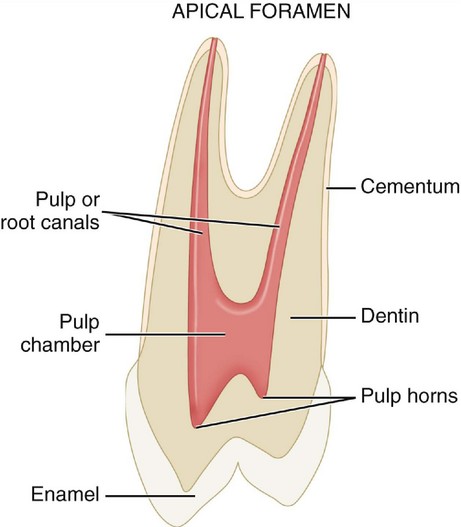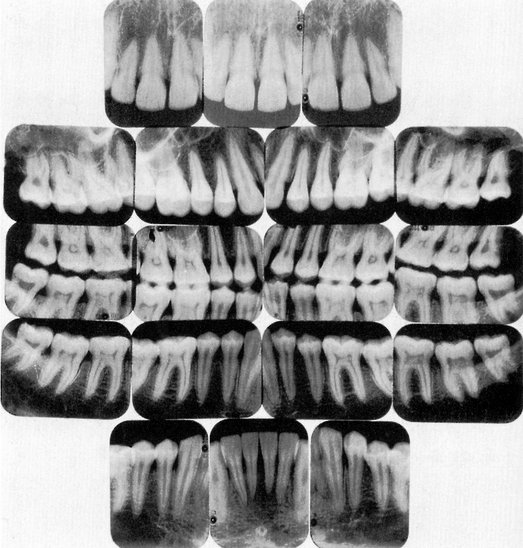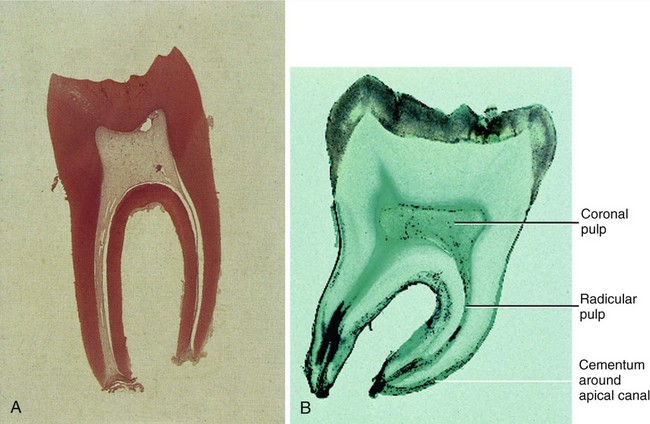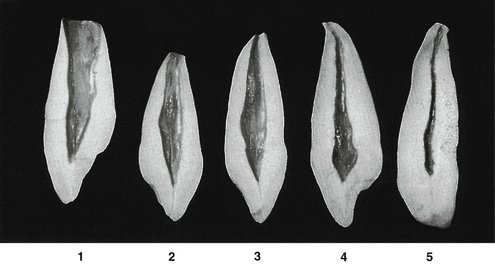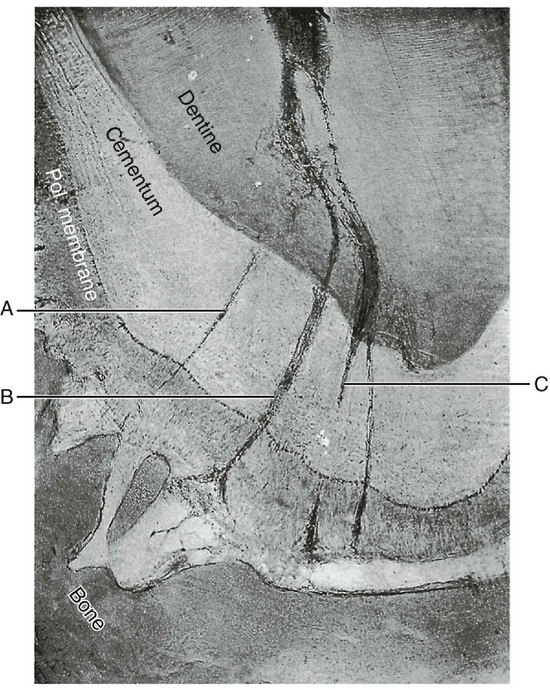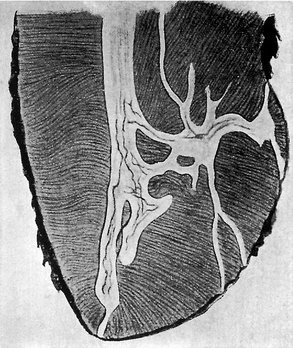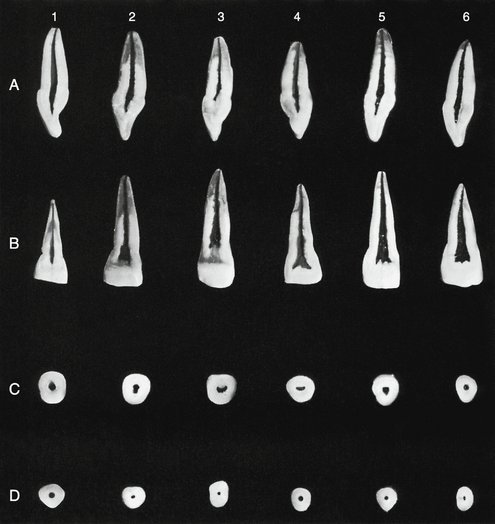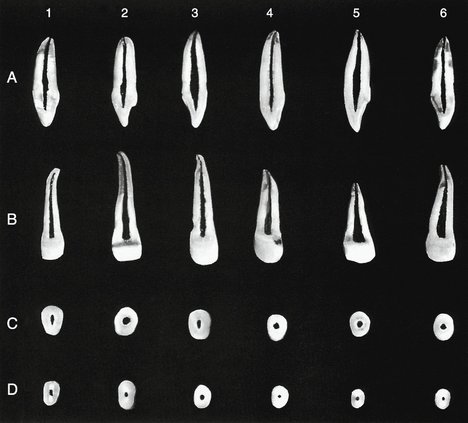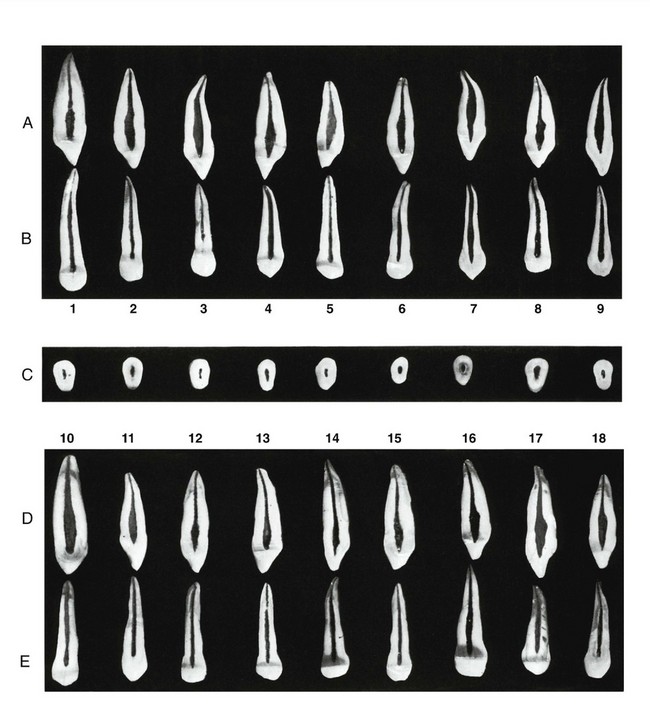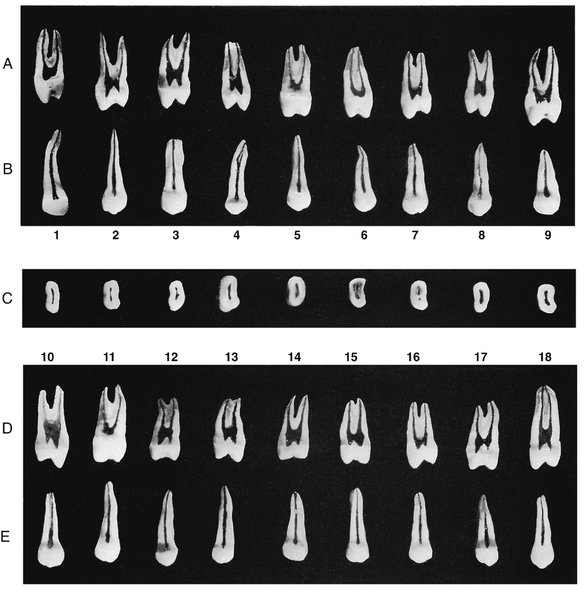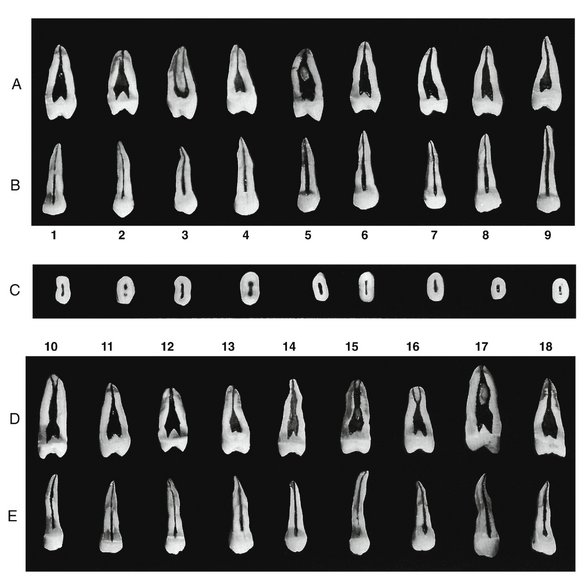13 Pulp Chambers and Canals
Pulp, Chamber, and Canals
The crown and root portion of a tooth that contains the pulp tissues has been arbitrarily divided into the pulp chamber and the root or pulp canal (Figure 13-1). The complexities of these cavities cannot be fully appreciated without studying longitudinal and transverse sections of each of the representative types of teeth.
Radiographs
The use of radiographs or digital radiography for the diagnosis and treatment of pulpal disease requires that the morphological features of the pulp chambers and root canals, which are three-dimensional, be visualized when compressed into a “two-dimensional” radiographic image. Thus, radiographic views taken of the teeth from a facial orientation show a monoplane, buccolingual view of the hard tooth structures and radiolucent spaces for the pulp and canals (Figure 13-2). Mesiodistal aspects of longitudinal sections usually are seen only incidentally (e.g., on radiographs of malposed, rotated teeth). Thus, the radiographic anatomy of the pulp cavity from a mesial-distal aspect is not well known. Radiographic views of the pulp chambers and canals will be considered in more detail later.
SIZE OF THE PULP CAVITY
The size of the pulp chamber depends on the age of the tooth and its history of trauma. Secondary dentin is formed continuously throughout the life of the tooth as a normal process, as long as the vitality of the tooth is maintained. The formation of secondary dentin is not uniform, because the odontoblasts adjacent to the floor and roof of the pulp cavity produce greater quantities of secondary dentin than do the odontoblasts located adjacent to the walls of the pulp cavity.1 Therefore the size of the pulp cavity is much larger in a young individual than in an adult (Figure 13-3, A and B) and should be considered before extensive tooth reduction is accomplished, especially in a young person.
Foramen
The neurovascular bundle, which supplies the internal contents of the pulp cavity, enters through the apical foramen or foramina (see Figure 13-1). As the root begins to develop, the apical foramen is actually larger than the pulp chamber (Figure 13-4, 1), but it becomes more constricted at the completion of root formation (Figure 13-4, 2 through 5).
It is possible for any root of a tooth to have multiple apical foramina. If these openings are large enough, the space that leads to the main root canal is called a supplementary or lateral canal (Figure 13-5). If the root canal breaks up into multiple tiny canals, it is referred to as a delta system2 because of its complexity (Figure 13-6).
Demarcation of Pulp Cavity and Canal
The cementoenamel junction (CEJ) is not quite at the level at which the root canal becomes the pulp chamber (see Figure 13-1). This demarcation is mainly macroscopically based but may be visualized by exploring the CEJ (see Figure 2-16) and noting the difference in density between the enamel and dentin at the mesial and distal tooth surfaces on radiographs. Enamel covers the external surface of the dentin, which makes up part of the pulp chamber, whereas cementum covers the entire external dentinal surface of the root canal space. The demarcation is simpler in multirooted teeth, because the pulp cavity within the root is the root canal and the remaining pulp cavity is the pulp chamber. Microscopically, the pulp within the chamber appears to be more cellular than the pulp found within the pulp of the root canal. The odontoblasts are cuboidal in the coronal pulp chamber but gradually flatten out as the apex is approached. The transition from the pulp chamber to the root canal is not sharply demarcated microscopically, and this demarcation is not sharply delineated macroscopically.
Pulp Horns
Projections or prolongations in the roof of the pulp chamber correspond to the various major cusps or lobes of the crown. The pulpal tissues that occupy these prolongations are called pulp horns (Figure 13-7). The prominence of the cusps or lobes corresponds with the development of the pulp horns. If the cusps or labial lobes are prominent (as in young individuals), one should expect to find equally prominent pulp horns underlying these structures (see Figure 13-8, B, 6). These projections become less prominent with time as a result of the formation of secondary dentin (see Figure 13-8, B, 1).
Pulp Cavities of the Maxillary Teeth
MAXILLARY CENTRAL INCISOR
Labiolingual Section (Figure 13-8, A)
The pulp cavity follows the general outline of the crown and root. The pulp chamber is very narrow in the incisal region. If a great amount of secondary or irritation-induced dentin has been produced, this portion of the pulp chamber may be partially or completely obliterated (Figure 13-8, A, 3). In the cervical region of the tooth, the pulp chamber increases to its largest labiolingual dimension.
Below the cervical area, the root canal tapers, gradually ending in a constriction at the apex of the tooth (apical constriction). The apical foramen is usually located near the very tip of the root but may be located slightly to the labial (Figure 13-8, A, 3, 4, and 5) or lingual aspect of the root (Figure 13-8, A, 1 and 6). Because of this generalized phenomenon it has been suggested that the root canal filling should appear on radiographs to extend no closer than 1 mm from the radiographic apex of the tooth. However, with the use of an electronic apical locator the clinician can have more confidence in more closely reaching the apex without overfilling.
Mesiodistal Section (Figure 13-8, B)
The pulp chamber is wider in the mesiodistal dimension than in the labiolingual dimension. The pulp cavity conforms to the general shape of the outer surface of the tooth. If prominent mamelons (see Figure 1-10, B) are or have been present, it is not unusual to find definite prolongations or pulp horns in the incisal region of the tooth (Figure 13-8, B, 5 and 6). The pulp cavity then tapers rather evenly along its entire length until reaching the apical constriction. The position of the apical foramen is usually slightly off center from the tip of the root, but some foramina deviate drastically from the apex of the root (Figure 13-8, B, 6).
Cervical and Midroot Cross Sections (Figure 13-8, C and D)
The pulp cavity is widest at about the cervical level, and the pulp chamber is generally centered within the dentin of the root (Figure 13-8, C, 1 through 5). In young individuals the pulp chamber is roughly triangular in outline, with the base of the triangle at the labial aspect of the root (Figure 13-8, C, 5). As the amount of secondary or reactive dentin increases, the pulp chamber becomes more round or crescent-shaped (Figure 13-8, C, 3, 4, and 6). The outline form of the root at the cervical level is typically triangular with rounded corners (Figure 13-8, C, 5 and 6), but some are more rectangular or angular with rounded corners (Figure 13-8, C, 1 through 4). The root and pulp canal tend to be rounder at the midroot level (Figure 13-8, D, 1 through 6) than at the cervical level. The anatomy at the midroot level is essentially the same as that found at the cervical level, just smaller in all dimensions.
MAXILLARY LATERAL INCISOR
Labiolingual Section (Figure 13-9, A)
The anatomy of the lateral incisor is similar to that of the central incisor. The pulp cavity of the lateral incisor generally follows the outline form of the crown and the root. The pulp horns are usually prominent. The pulp chamber is narrow in the incisal region and may become very wide at the cervical level of the tooth (Figure 13-9, A, 1, 2, 3, and 5). Those teeth lacking this cervical enlargement of the pulp chamber possess a root canal that tapers slightly to the apical constriction (Figure 13-9, A, 4 and 6). Many of the apical foramina appear to be located at the tip of the root in the labiolingual aspect (Figure 13-9, A, 1, 4, and 6), whereas some exit on the labial (Figure 13-9, A, 2, and 3) or lingual aspect of the root tip (Figure 13-9, A, 5).
Mesiodistal Section (Figure 13-9, B)
The pulp cavity closely follows the external outline of the tooth. The pulpal projections or pulp horns appear to be blunted when viewed from the labial aspect of the tooth. The pulp chamber and root canal gradually taper toward the apex, which often demonstrates a significant curve toward the distal in the apical region (Figure 13-9, B, 1 through 4, and 6).
Cervical and Midroot Cross Sections (Figure 13-9, C and D)
The cervical cross section shows the pulp chamber to be centered within the root. The root form of this tooth shows a large variation in shape (see the discussion of the lateral incisor in Chapter 6). The outline form of this tooth may be triangular, oval, or round (Figure 13-9, C, 1 through 6). The pulp chamber generally follows the outline form of the root, but secondary dentin may narrow the canal significantly (Figure 13-9, D, 4 and 6).
MAXILLARY CANINE
Labiolingual Section (Figure 13-10, A and D)
The incisal aspect of the canine corresponds to the shape of the crown. If a prominent cusp is present, a long narrow projection from the pulp chamber (the pulp horn) will be present. The pulp chamber and incisal third or half of the root canal may be very wide, showing a very abrupt constriction of the root canal in the apical region, which then gently tapers toward the apex (Figure 13-10, A, 4, 5, 6, and 8; D, 16, 17, and 18). In other instances, a root canal may taper evenly from the pulp chamber to the apex of the root (Figure 13-10, A, 9; D, 10, 11, 13, and 14).
Some canines have severe curves in the apical aspect of the root (Figure 13-10, A, 3 and 7). The apical foramen may appear to exit at the tip of the root (Figure 13-10, A, 2 and 5 through 8; D, 11, 17, and 18) or labially to the apex of the root (Figure 13-10, A, 1, 3, and 4; D, 12 through 16).
Mesiodistal Section (Figure 13-10, B and E)
The pulp cavity is much narrower in the mesiodistal aspect. The dimension and degree of taper of the pulp canal of the maxillary canine are very similar to those of the central and lateral incisors; however, the cuspid has a much longer root. The pulp cavity gently tapers from the incisal aspect to the apical foramen. A mesial or distal curve of the apical root may be present (Figure 13-10, B, 1, 4, 6, and 8; E, 14, 17, and 18). The apical foramen may appear to exit at the tip of the root (Figure 13-10, B, 1, 3 through 5, 7, and 9; E, 10, 11, 13, 14, 17, and 18) or slightly to the mesial or distal aspect of the root (Figure 13-10, B, 2, 6, and 8; E, 12, 15, and 16).
Cervical Cross Section (Figure 13-10, C)
In cervical cross section, the shape of the root and pulp cavity is oval (Figure 13-10, C, 6, 7, and 9), triangular (Figure 13-10, C, 8), or elliptical (Figure 13-10, C, 1 through 5). The pulp chamber and canal are often centered within the crown and root (Figure 13-10, C, 1, 3, 4, and 9).
MAXILLARY FIRST PREMOLAR
Buccolingual Section (Figure 13-11, A and D)
The maxillary first premolar may have two well-developed roots (Figure 13-11, A, 1, 2, and 9; D, 10 and 14), two root projections that are not fully separated (Figure 13-11, A, 3, 5, 7, and 8; D, 11, 12, 13, 15, 16, and 17), or one broad root (Figure 13-11, A, 4 and 6; D, 18). The majority of maxillary first premolars have two root canals (Figure 13-11, A and D). A small percentage of maxillary first premolar teeth may have three roots that may be almost undetectable radiographically.
The pulp horn usually extends further incisally under the buccal cusp, because this cusp is usually better developed than the lingual cusp. The pulp horns may be blunted (Figure 13-11, A, 1, 5, and 6; D, 11) in teeth possessing cusps that demonstrate a fair amount of attrition. The pulp chamber floor is below the cervical level of all the variations found in the maxillary first premolar. The pulp chamber of teeth having the least root separation usually shows the largest incisal-apical dimension (Figure 13-11, A, 4; D, 18). Those teeth possessing a partial root separation may also have this large dimension (Figure 13-11, A, 8; D, 10). Teeth having two separate canals usually demonstrate a rather small pulp chamber in the incisal-apical direction (Figure 13-11, A, 1, 2, and 9; D, 11 and 14). The shape of the pulp chamber (excluding the pulp horns) tends to be square (Figure 13-11, A, 1 and 8; D, 10, 12, 13, 14, and 18) or rectangular (Figure 13-11, A, 2 through 7; D, 11, 15, 16, and 17).
The root canal often appears to exit at the tip of the root (Figure 13-11, A, 1, 4, 6, 7, and 8; B, 12, 13, and 15 through 18), slightly to the labial or lingual (Figure 13-11, A, 2), or a combination of the two locations (Figure 13-11, A, 3, 5, and 9; B, 10, 11, and 14).
Mesiodistal Section (Figure 13-11, B and E)
The apical foramen appears to exit at the tip of the root most of the time (Figure 13-11, B, 1, 2, 3, and 6 through 9; E, 10 and 12 through 18), but some appear to exit on the mesial or distal aspects of the root (Figure 13-11, B, 4 and 5; E, 11).
Cervical Cross Section (Figure 13-11, C)
The cross section at the cervical level shows the kidney-shaped outline form characteristic of the maxillary first premolar (Figure 13-11, C). A mesial developmental groove is usually present, giving this tooth its classic indentation. The pulp cavity may demonstrate a constriction adjacent to the developmental groove (Figure 13-11, C, 2, 3, 5, 6, and 9), or it may follow the general outline of the root surface (Figure 13-11, C, 1, 4, 7, and 8). Some roots demonstrate two separate root canals (Figure 13-11, C, 7), whereas a cross section of a three-rooted maxillary first premolar will show three separate canals (Figure 13-11, C, 3).
MAXILLARY SECOND PREMOLAR
Buccolingual Section (Figure 13-12, A and D)
The pulp cavity may demonstrate well-developed pulp horns (Figure 13-12, A, 1, 2, 6, 7, and 8; D, 10, 11, 12, 14, 16, and 17); others may have blunted or nonexistent pulp horns (Figure 13-12, A, 3, 4, 5, and 9; D, 13, 15, and 18). The pulp chamber and root canal are very broad in the buccolingual aspect of teeth with single canals. The pulp cavity does not show a well-defined demarcation between the root cavity and the pulp cavity because of the large buccolingual extent of the pulp cavity in the upper half of the tooth. In the apical half or third of the tooth, the pulp cavity often narrows abruptly (Figure 13-12, A, 1, 2, 4, 6, and 8; D, 11, 12, 13, and 18) and then tapers gently toward the apex. Some teeth possess dentinal islands in the apical third of the root; this situation essentially forces the clinician to treat these as teeth with two canals (Figure 13-22, A, 5; D, 15 and 17). Other maxillary second premolars have a canal that bifurcates at the apical third of the root (Figure 13-12, D, 10, 15, and 16). It should also be noted that buccal and lingual pulpal projections or fins are present at the level of the CEJ (Figure 13-12, A, 2; D, 12 and 18). Some teeth show a constriction at this same level (Figure 13-12, D, 10).
The apical foramen often appears to exit at the tip of the root (Figure 13-12, A, 1, 2, 5, 6, and 8; D, 11, 12, and 14 through 18). Some apical foramina appear to exit on the buccal aspect of the root (Figure 13-12, A, 4; D, 13), on the lingual aspect of the root (Figure 13-12, A, 7 and 9), or on both sides of the root tip (Figure 13-12, A, 3; D, 10 and 15).
Mesiodistal Section (Figure 13-12, B and E)
The view of the pulp cavity in the mesiodistal section of the second maxillary premolar does not vary from that found in the maxillary first premolar. The pulp horns are blunted, and the pulp cavity tapers slightly from the occlusal aspect to the apex. The apical foramen may appear to be located off center of the root tip (Figure 13-12, A, 2, 6, and 9; D, 10 and 13) or appear to exit at the root tip (Figure 13-12, B, 1, 3, 4, 5, 7, and 8; E, 11, 12, and 14 through 18).
Cervical Cross Section (Figure 13-12, C)
The cervical cross section of the maxillary second premolar is usually oval (Figure 13-12, C, 2 and 4 through 9), with some teeth having a kidney-shaped cross section (Figure 13-12, C, 1 and 3). The pulp cavity is centered in the root and may have a constriction in the middle of the canal space (Figure 13-12, C, 1, 4, 6, and 9), an entire separation (Figure 13-12, C, 2), or an elliptical pulp cavity (Figure 13-12, C, 3, 5, 7, and 8).
MAXILLARY FIRST MOLAR
Buccolingual Section (Figure 13-13, A and D)
The buccolingual section of the maxillary first molar in Figure 13-13 shows the pulp cavities of the mesiobuccal and palatal root. These roots were chosen to demonstrate the pulp cavity anatomy because of the complexity of the mesiobuccal root. The distobuccal root is straighter and smaller and presents fewer variations in shape. The entire removal of the pulp is an impossibility in many maxillary first molar teeth because of the complexities of the root canal system (see Figure 13-7).
The pulp horns are usually prominent in this tooth (Figure 13-13, A, 1, and 4 through 8; D, 10 through 13, and 15 through 18). The pulp chamber is somewhat rectangular (excluding the pulp horns) when viewed from the mesial aspect of the tooth. The palatal root usually has the largest canal (Figure 13-13, A, 1, 2, 3, 5, and 6; D, 10, 15, 17, and 18). The mesiobuccal canal is often very small (Figure 13-13, A, 2 and 6; D, 10, 14, and 17), but some mesiobuccal canals may be very wide within a very wide root (Figure 13-13, A, 9; D, 12 and 13).
The presence of an unmarked MB2 is strongly suggested when the root canal appears to be off to one side (Figure 13-13, A, 2, 6, and 8; D, 10, 11, 13, 14, 15, 17, and 18).
The root canals of the wide mesiobuccal roots are widest at the midroot level and taper to a very fine diameter at the apical foramen. The palatal root canal and the mesiobuccal root canal of most teeth taper gently to the apical region, where they terminate at or near the apex. The apical foramen of the palatal canal may appear to exit at the apex (Figure 13-13, A, 1, and 4 through 9; D, 11 through 17), slightly lingually (Figure 13-13, A, 2; D, 10) or buccally to the root tip (Figure 13-13, A, 3; D, 18).
The apical foramen of the mesiobuccal canal may appear to exit on the tip of the root (Figure 13-13, A, 2 through 5, 7, 8, and 9; D, 10, 12, 13, 17, and 18) or on the buccal (Figure 13-13, A, 1 and 6; D, 14 and 15) or lingual (Figure 13-13, D, 16) aspect of the root.
Mesiodistal Section (Figure 13-13, B and E)
The mesiodistal section of the maxillary first molar includes the distobuccal root, which was not visible on the previously mentioned buccolingual section. The mesiobuccal root has a great tendency to possess a more curved root and canal than the distobuccal root (Figure 13-13, B, 1 through 8; E, 12, 14, and 15). Some of the buccal canals are relatively straight (Figure 13-13, E, 10, 11, and 13).
The pulp horns are very distinct from this view, with the mesiobuccal pulp horn usually appearing a little larger than the distobuccal pulp horn (
Stay updated, free dental videos. Join our Telegram channel

VIDEdental - Online dental courses


